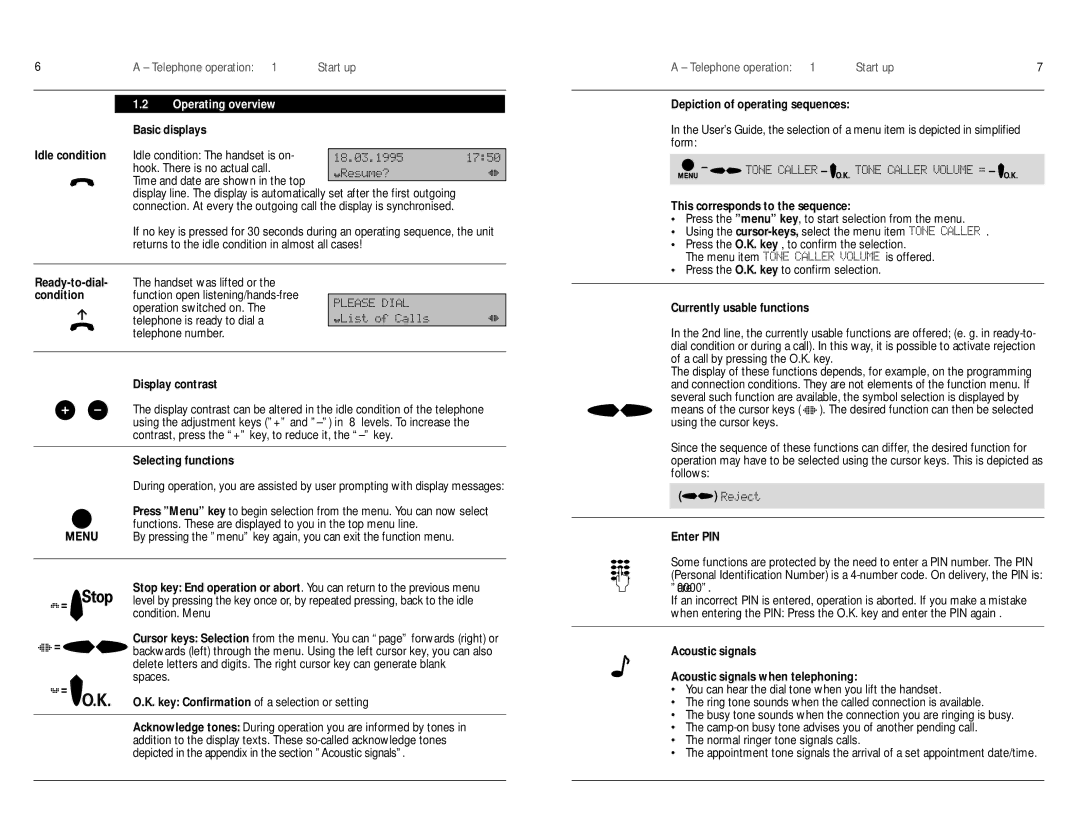
6 | A – Telephone operation: 1 | Start up |
1.2Operating overview Basic displays
Idle condition Idle condition: The handset is on- hook. There is no actual call.
Time and date are shown in the top
display line. The display is automatically set after the first outgoing connection. At every the outgoing call the display is synchronised.
If no key is pressed for 30 seconds during an operating sequence, the unit returns to the idle condition in almost all cases!
condition function open
Display contrast
The display contrast can be altered in the idle condition of the telephone using the adjustment keys (”+” and
Selecting functions
During operation, you are assisted by user prompting with display messages:
Press ”Menu” key to begin selection from the menu. You can now select functions. These are displayed to you in the top menu line.
By pressing the ”menu” key again, you can exit the function menu.
Stop key: End operation or abort. You can return to the previous menu
= ![]() level by pressing the key once or, by repeated pressing, back to the idle condition. Menu
level by pressing the key once or, by repeated pressing, back to the idle condition. Menu
Cursor keys: Selection from the menu. You can “page” forwards (right) or
=backwards (left) through the menu. Using the left cursor key, you can also delete letters and digits. The right cursor key can generate blank spaces.
=
O.K. key: Confirmation of a selection or setting
Acknowledge tones: During operation you are informed by tones in addition to the display texts. These
A – Telephone operation: 1 | Start up | 7 |
Depiction of operating sequences:
In the User’s Guide, the selection of a menu item is depicted in simplified form:
– | – | – |
|
This corresponds to the sequence:
•Press the ”menu” key, to start selection from the menu.
• Using the | . |
•Press the O.K. key , to confirm the selection.
The menu item | is offered. |
•Press the O.K. key to confirm selection.
Currently usable functions
In the 2nd line, the currently usable functions are offered; (e. g. in
The display of these functions depends, for example, on the programming and connection conditions. They are not elements of the function menu. If several such function are available, the symbol selection is displayed by means of the cursor keys ( ). The desired function can then be selected using the cursor keys.
Since the sequence of these functions can differ, the desired function for operation may have to be selected using the cursor keys. This is depicted as follows:
(![]() )
)
Enter PIN
Some functions are protected by the need to enter a PIN number. The PIN (Personal Identification Number) is a
If an incorrect PIN is entered, operation is aborted. If you make a mistake when entering the PIN: Press the O.K. key and enter the PIN again .
Acoustic signals
Acoustic signals when telephoning:
•You can hear the dial tone when you lift the handset.
•The ring tone sounds when the called connection is available.
•The busy tone sounds when the connection you are ringing is busy.
•The
•The normal ringer tone signals calls.
•The appointment tone signals the arrival of a set appointment date/time.
